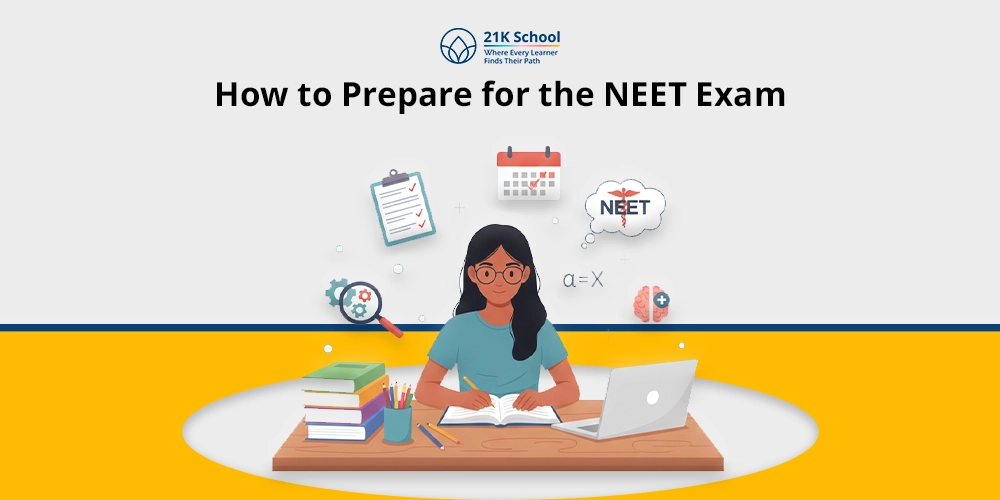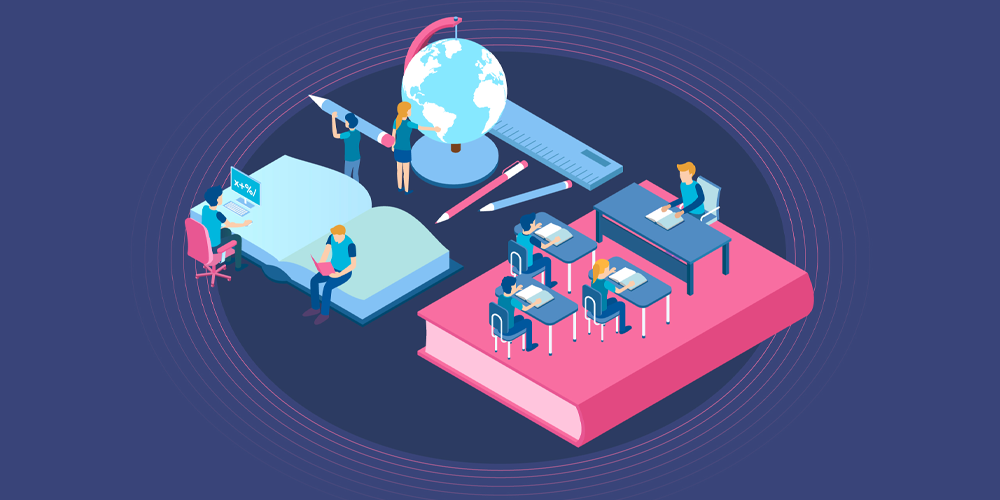
The use of technology has affected virtually all fields, and education is among the most influential sectors in this modern society.
Digital classrooms, one of the growing trends and innovations in teaching and learning practice, are paving the way for a more inclusive, flexible, and engaging educational experience.
21K School, a reputed homeschooling institution, is stepping into this transformation as it is one of the pioneers in providing digital learning solutions that cater to the diverse needs of learners worldwide.
Contents
- 1 What is a Digital Classroom?
- 2 How Does Learning Work in a Digital Classroom?
- 3 Key Features of Digital Classrooms
- 4 How to Create a Digital Classroom?
- 5 Difference Between Digital Classrooms and Smart Classrooms
- 6 What Benefits Do Digital Classrooms Offer?
- 7 Key Components of a Digital Classroom
- 8 How 21K Schools Utilise Digital Classrooms?
- 9 The Role of Facilitators in Digital Classrooms
- 10 The Future of Digital Classrooms
- 11 Conclusion
What is a Digital Classroom?
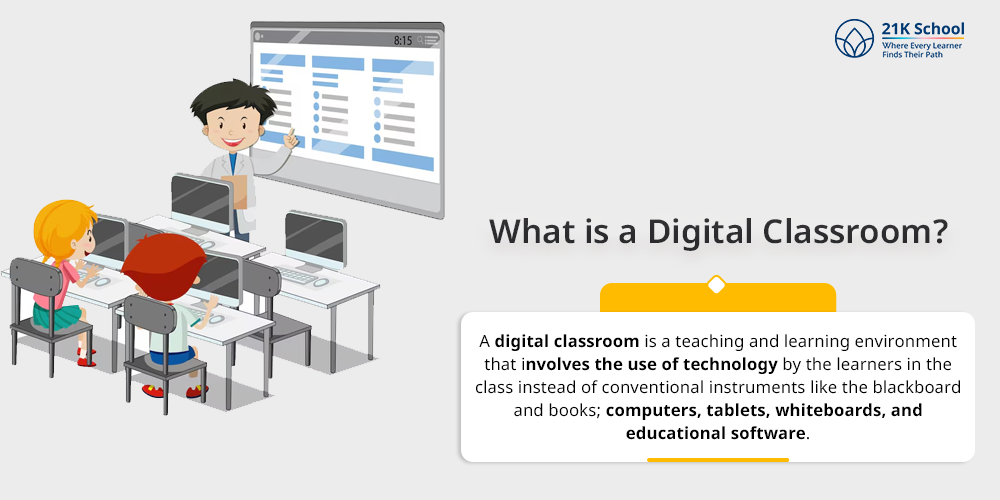
A digital classroom is a teaching and learning environment that involves the use of technology by the learners in the class instead of conventional instruments like the blackboard and books; computers, tablets, whiteboards, and educational software.
This approach uses the internet and digital media to teach the learners, making education more interactive and accessible
How Does Learning Work in a Digital Classroom?
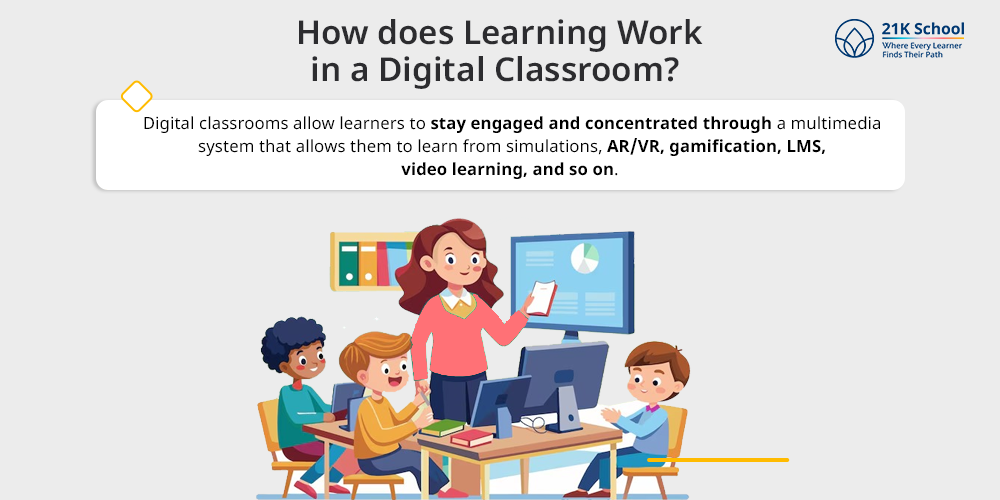
Digital classrooms implement technology and technical resources to enhance the teaching and learning process.
Digital classrooms are different from virtual classrooms, as in virtual classrooms, learners learn from their own homes with the help of video lessons and virtual learning platforms, whereas in digital classrooms, learners learn in a physical mode by using digital tools such as computers, tablets, smart displays, projectors, simulations, under the guidance of facilitators.
Integration of technology helps learners to enhance collaboration and promotes collaborative learning.
Digital classrooms allow learners to stay engaged and concentrated through a multimedia system that allows them to learn from simulations, AR/VR, gamification, LMS, video learning, and so on.
Digital classrooms provide learners with flexible and customised education, which makes education easy and comfortable for them.
Key Features of Digital Classrooms
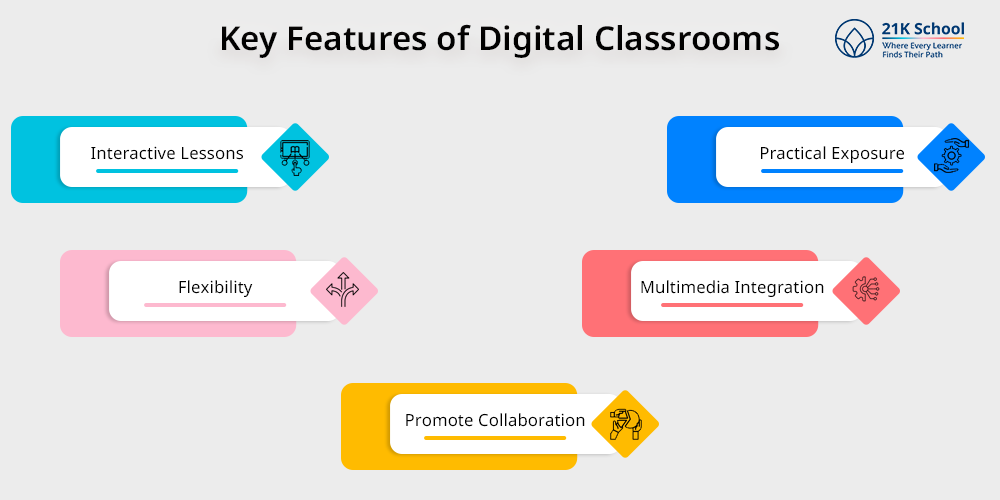
Digital classrooms have changed the teaching and learning process with the implementation of technology into education.
Digital classrooms use technology and technical tools to provide interactive and engaging classes to improve the learning outcomes of learners. Here are the features of digital classrooms mentioned below:
- Interactive Lessons: Digital classrooms provide engaging and interactive lessons. The use of digital tools such as multimedia systems, gamification, digital boards, and practical classes allows learners to engage more effectively and promotes active learning.
- Flexibility: One of the incredible aspects of digital literacy is that it provides flexible education. As every learner has their own way of understanding concepts, flexible education allows them to study at their own pace. Various digital tools and resources help learners to enhance their learning experience.
- Promote Collaboration: By implementing digital classrooms, learners were able to collaborate better with others. Digital classrooms enable the use of various tools in the classroom that allow for effective communication skills with others, and allow for participation in group projects or social activities, which enables them to develop collaboration skills.
- Multimedia Integration: Digital classrooms allow the use of multimedia system that enables learners to grasp difficult concepts easily. Through multimedia integration, education becomes more interactive as it includes simulations, podcasts, animations, and videos.
- Practical Exposure: Digital classrooms provide learners practical experience through virtual labs and simulations. These methods provide an interactive way of learning practical concepts with simulations that allow learners to perform experiments, hypothesis, research, etc.
How to Create a Digital Classroom?
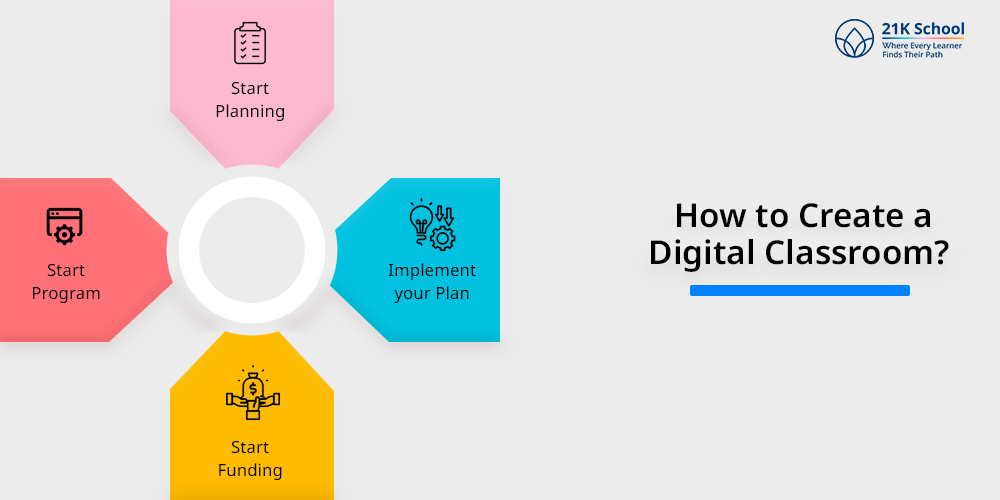
Digital classrooms are necessary for promoting holistic education and providing learners with practical exposure. Digital classrooms can be created to foster innovation in education.
Before creating a digital classroom, it is essential to create a positive learning environment which requires active learner participation. Here is how you can create a digital classroom.
- Start Planning: Before the setup of digital classrooms, it is essential to create a perfect plan and define your objectives. After the planning, it is essential to start preparation by assessing the needs of learners, such as learning style, background, suitable tools, etc. Once everything is done next step is to create guidelines and proper dependability.
- Implement your Plan: Once you have planned your setup, the next step is to start implementing your plan. Choose numerous e-learning platforms and LMS to build the hub of digital classrooms. It is essential to incorporate some engaging elements for activity-based learning, such as puzzles, MCQs, quizzes, group projects, etc. Also include multimedia content that enables learners to learn more effectively.
- Start Funding: After implementing the plan, funding is the crucial part to execute the plan of digital classrooms. You can start your funding from government sources, organisation funding, or even partnership with various NGO, and collaboration with organisations helps in getting sponsorship. It is also beneficial to take part in fundraising activities to raise funds for the resources.
- Start Program: Once you have finished everything, it is essential to start the classes, provide guidance and mentorship to learners about e-learning platforms and how to utilise technology. Encourage learners’ participation with collaborative learning, activities, projects, etc. It is also very essential to take feedback from learners and their parents, as this will enable them to understand the weaknesses and strengths.
Difference Between Digital Classrooms and Smart Classrooms
Digital classrooms and smart classrooms are both related to technology and modern ethics, however, both are used interchangeably. Digital classrooms are all about using electronic tools such as laptops, computers, displays, smartboards, etc.
Whereas, smart classrooms are learning method of enhancing the teaching and learning process with the help of modern technologies.
Here, you can check the detailed comparison between smart classrooms and digital classrooms mentioned below.
| Aspects | Digital Classroom | Smart Classroom |
| Definition | The digital classroom can be defined as implementing technology and technical resources such as smart displays, projectors, computers, smartboards, etc. | The smart classroom is the process of implementing technical resources and teaching methods to enhance the teaching and learning process. |
| Objective | The goal of a digital classroom is to close learning gaps, increase learner engagement, decrease dropout rate, facilitate individualised learning, engage learners in remedial learning and observe measurable improvements in learning outcomes. | The objective of the smart classroom is to increase learner engagement and attendance while also potentially observing some improvement in learning outcomes. |
| Focus | A digital classroom focuses on enhancing the teaching and learning process for both facilitators and learners. | A smart classroom focuses on enhancing the teaching experience through various resources and effectiveness. |
| Implementation | A digital classroom can be implemented in both a classroom setting as well as a home learning environment. | Smart classrooms are only limited to physical classrooms and can be implemented in physical mode only. |
| Examples | A digital classroom is a computer and projector-equipped classroom where learners can conduct online research and give presentations. | A smart classroom is equipped with multimedia projectors, interactive whiteboards and online collaboration tools for group projects and interactive instruction. |
What Benefits Do Digital Classrooms Offer?
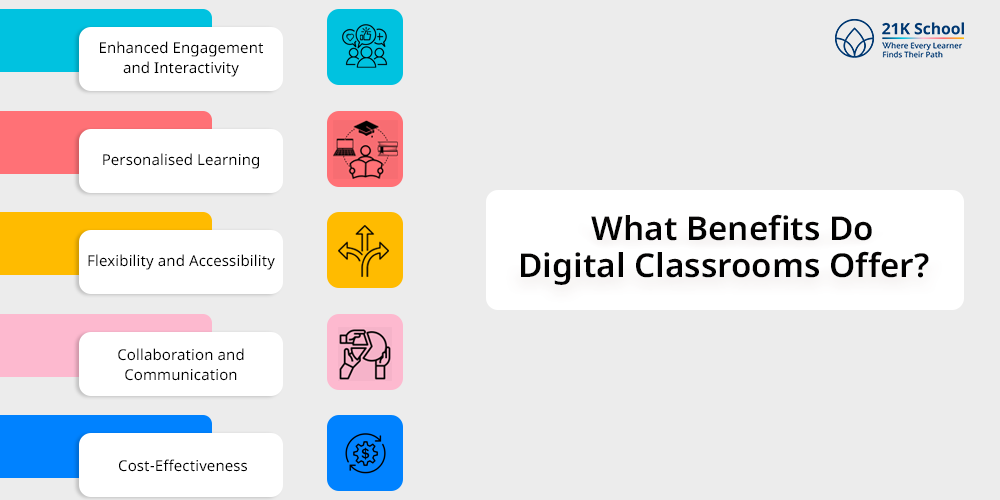
1. Enhanced Engagement and Interactivity
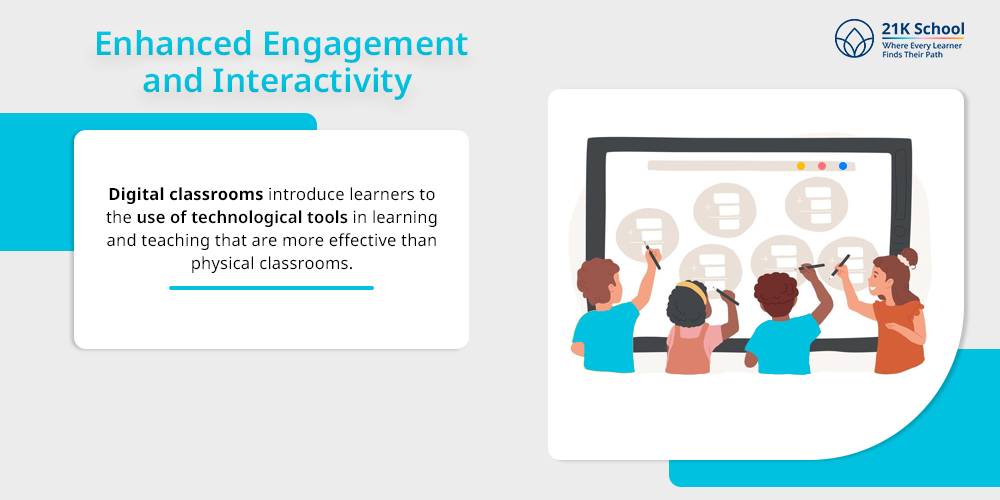
Digital classrooms introduce learners to the use of technological tools in learning and teaching that are more effective than physical classrooms.
Interacting with content, using video animations or simulations more often, is engaging and enhances interest in learning. In addition, the use of quizzes and game formats for learning maintains learners’ attention and engagement.
2. Personalised Learning
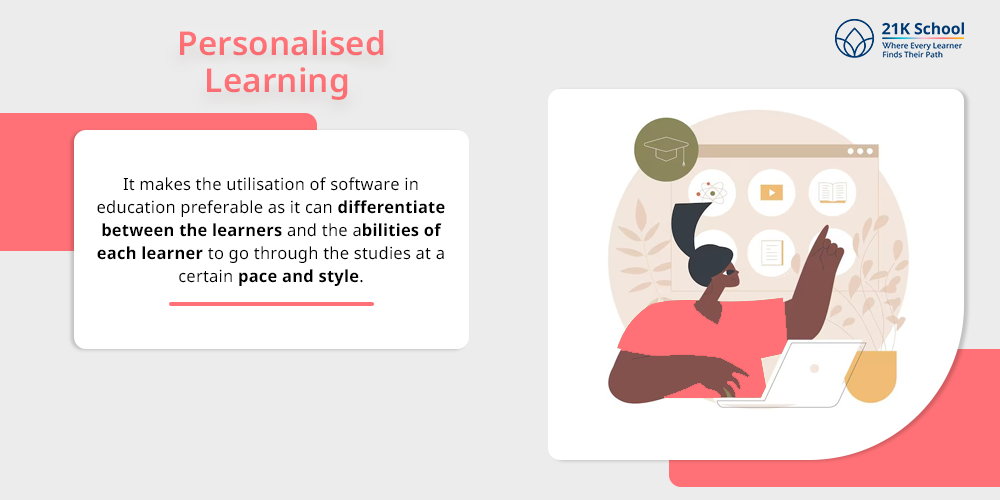
Another major benefit associated with learning delivery in digital classrooms is the extent of customisation.
It makes the utilisation of software in education preferable as it can differentiate between the learners and the abilities of each learner to go through the studies at a certain pace and style.
This way, every learner receives the support they need to succeed.
3. Flexibility and Accessibility
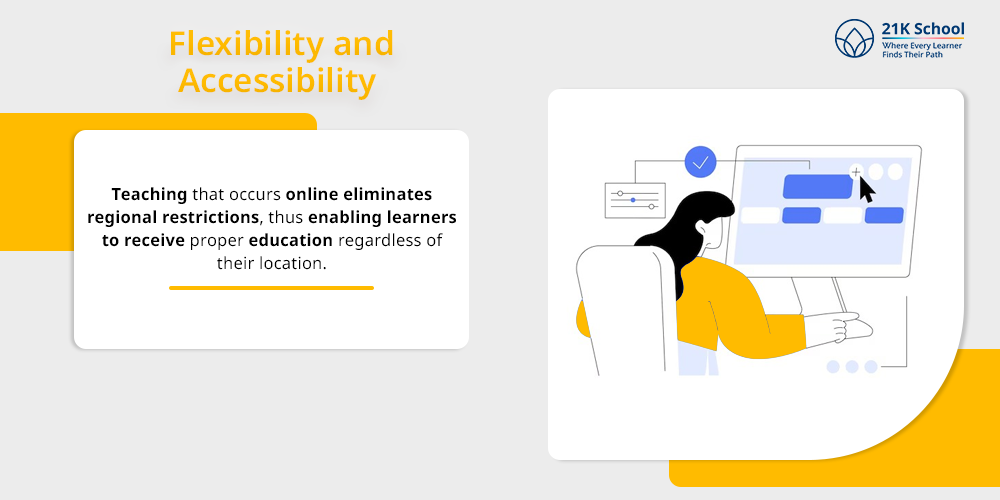
Teaching that occurs online eliminates regional restrictions, thus enabling learners to receive proper education regardless of their location.
This flexibility is especially a plus for online high school families, like those using 21K School, enabling learners to learn at their own pace and schedule.
4. Collaboration and Communication
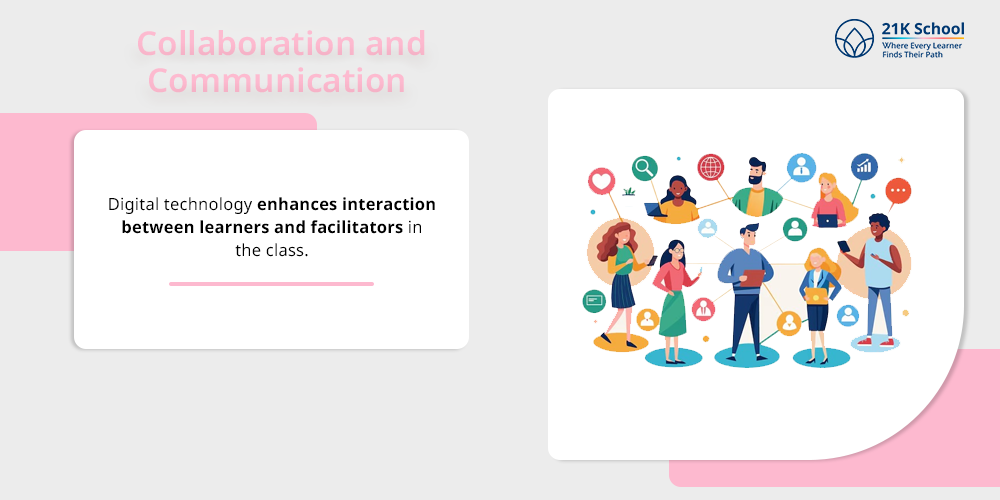
Digital technology enhances interaction between learners and facilitators in the class.
Discussion boards, video conferencing, and assigning project-based assignments to learners enable the learners to work in groups; share ideas, discuss with the facilitators, and get feedback immediately.
5. Cost-Effectiveness
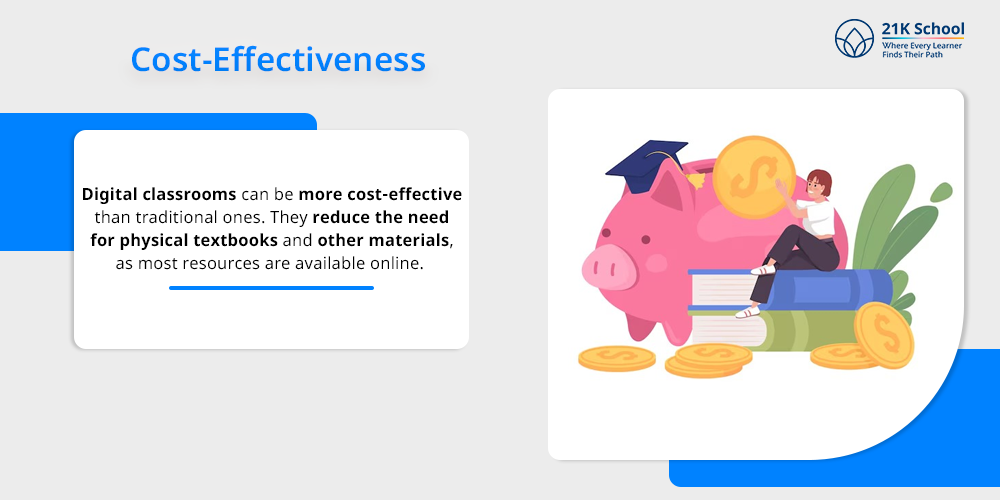
Digital classrooms can be more cost-effective than traditional ones. They reduce the need for physical textbooks and other materials, as most resources are available online. This can significantly lower the cost of education for families.
Key Components of a Digital Classroom
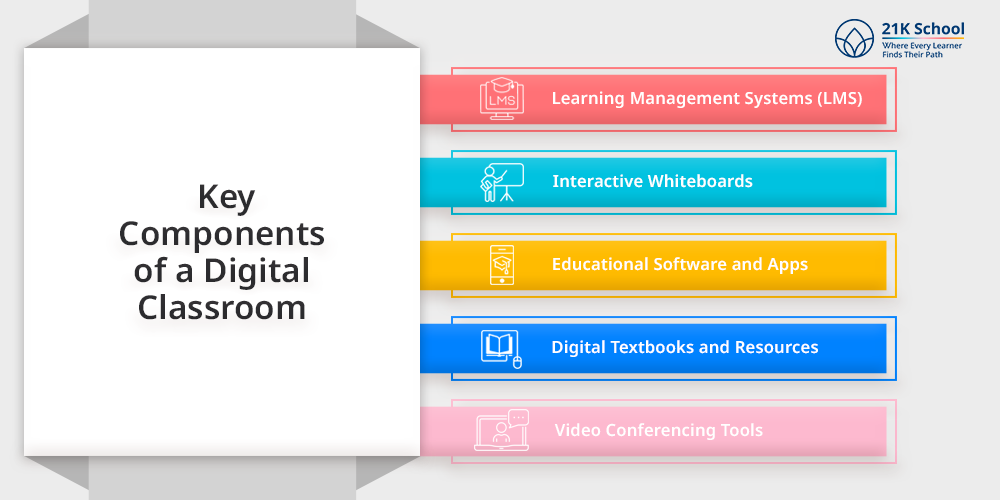
1. Learning Management Systems (LMS)

An LMS is defined as an application that aids in the administration of learning processes in an organisation.
It allows presenting the course material, monitoring the learners’ achievements, and giving quizzes and tests. Some of the widely used LMSs are Moodle, Canvas, and Google Classroom.
2. Interactive Whiteboards
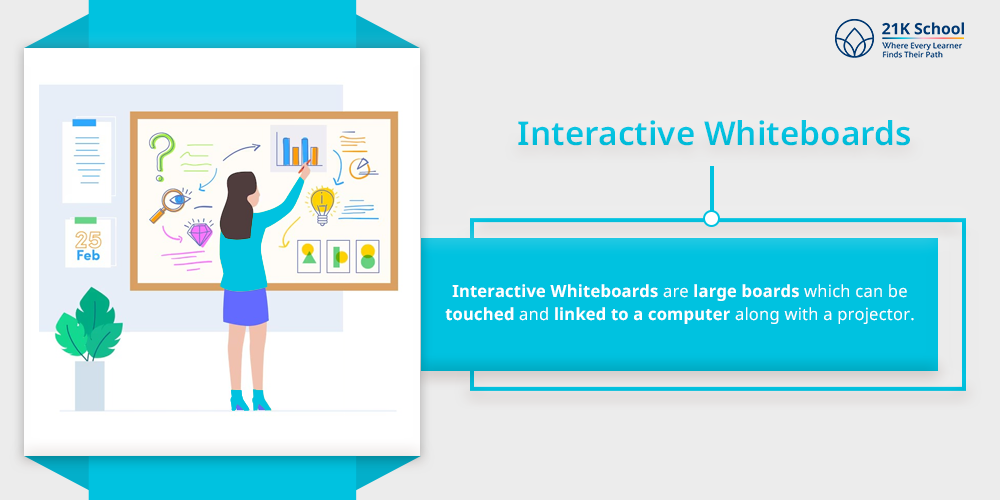
Interactive Whiteboards are large boards which can be touched and linked to a computer along with a projector.
They enable the teacher to present and manipulate content on screen, which enhances dynamics in lessons. These whiteboards are multi-functional in that they can be used to draw, write, and even play learning games.
3. Educational Software and Apps
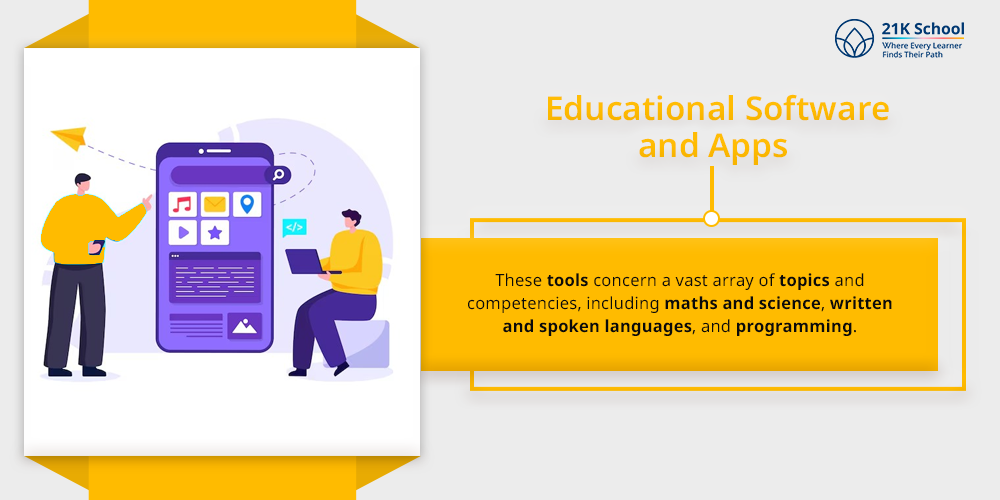
Education software and apps all have the aim of helping a learner to gain insight into a subject.
These tools concern a vast array of topics and competencies, including maths and science, written and spoken languages, and programming.
Its features may lie in the incorporation of teasing lessons, quizzes, and games that enable effective learning.
4. Digital Textbooks and Resources
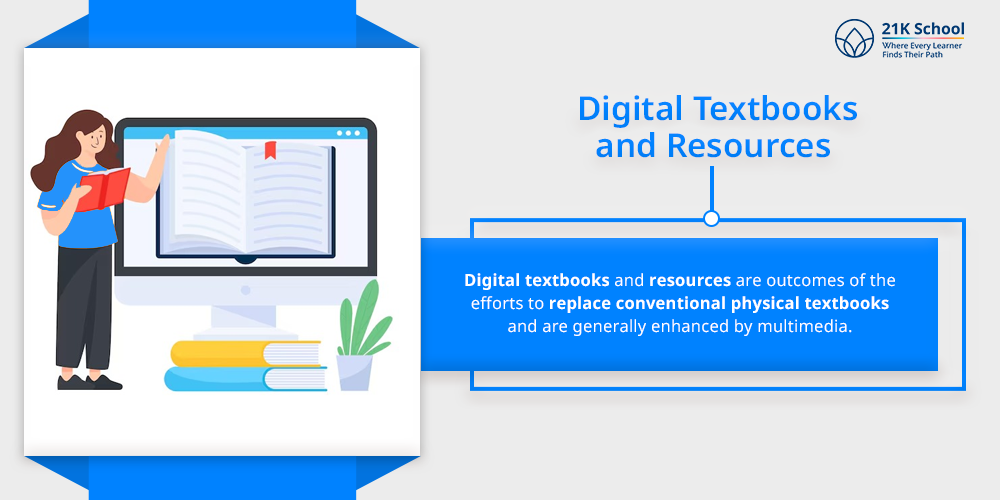
Digital textbooks and resources are outcomes of the efforts to replace conventional physical textbooks and are generally enhanced by multimedia.
They are quite convenient and can be frequently revised to provide the most up-to-date information to learners.
5. Video Conferencing Tools
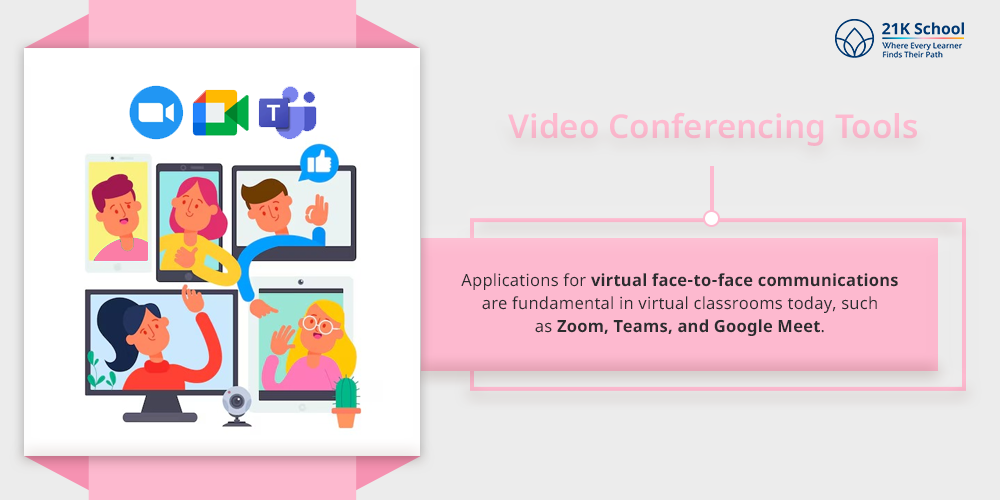
Applications for virtual face-to-face communications are fundamental in virtual classrooms today, such as Zoom, Teams, and Google Meet.
They enable facilitators to give lessons directly, engage the learners in discussions, and even offer individual help to the learners.
How 21K Schools Utilise Digital Classrooms?
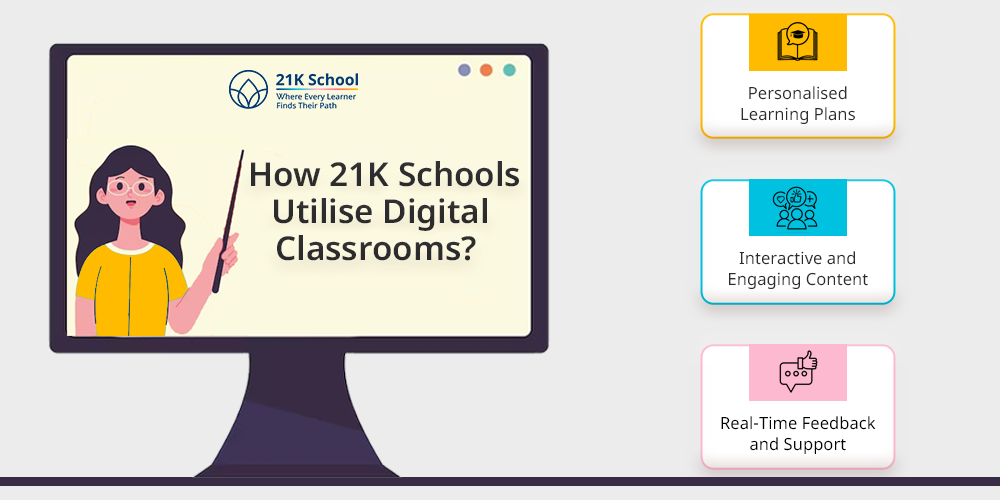
As for 21K School, the platform aims to provide operational and versatile homeschooling with the help of digital classes.
Through implementing and utilising different kinds of technology effectively and efficiently, 21K School guarantees its learners a quality, interesting, and competent education.
1. Personalised Learning Plans
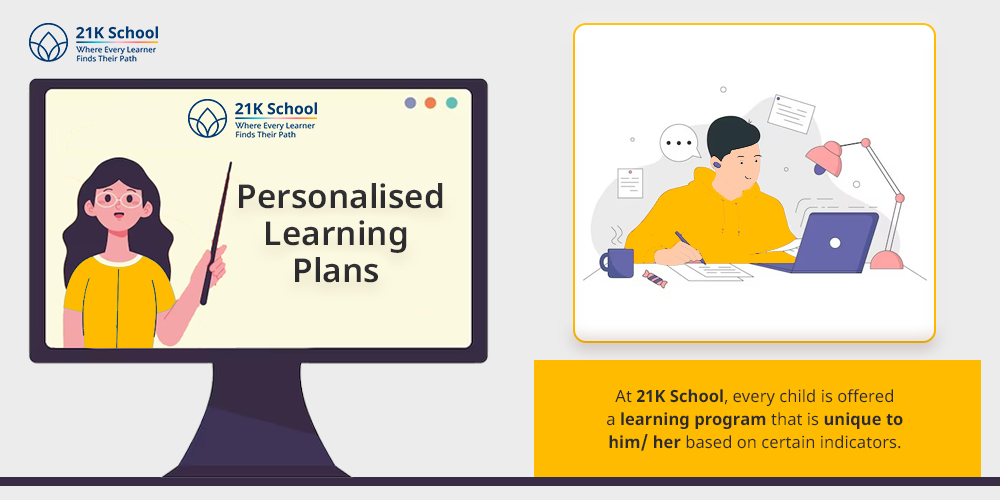
At 21K School, every child is offered a learning program that is unique to him/her based on certain indicators.
Such an approach makes it possible for the learners to be able to study at their convenience and at the same time get all the help that they need.
2. Interactive and Engaging Content
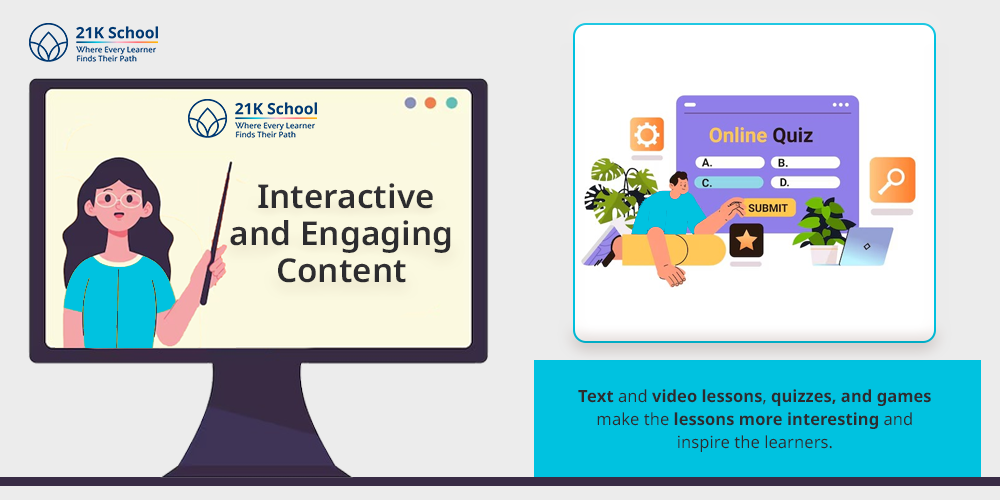
21K School employs multimedia content to enhance learning and make lessons and homeschooling more interesting.
Text and video lessons, quizzes, and games make the lessons more interesting and inspire the learners.
3. Real-Time Feedback and Support
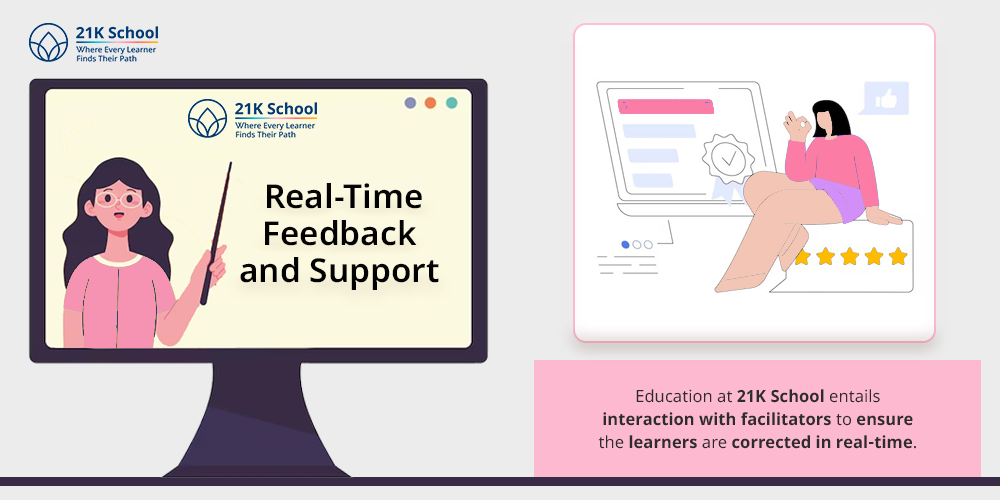
Education at 21K School entails interaction with facilitators to ensure the learners are corrected in real-time.
The combined use of social networks, discussion groups, and videoconferencing makes communication free and guarantees the opportunity to turn to learners for help at any time.
The Role of Facilitators in Digital Classrooms
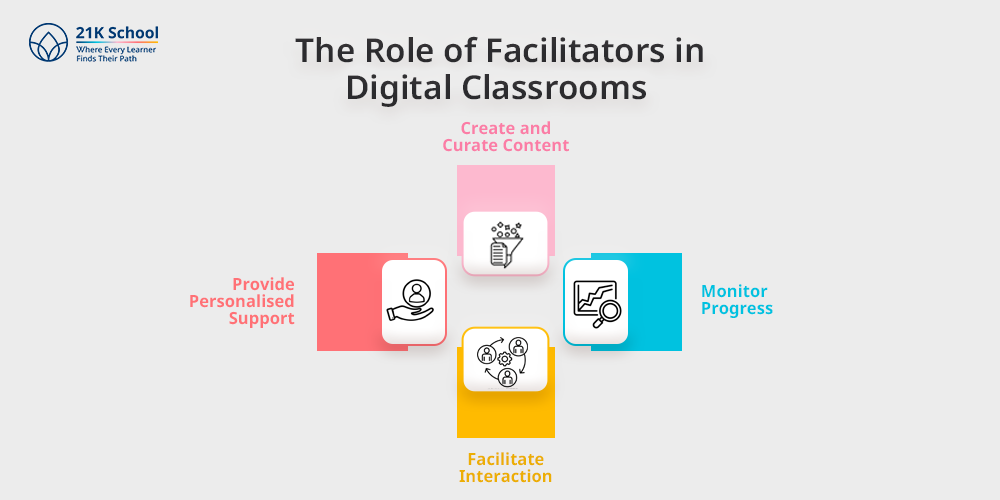
In digital classrooms, the role of facilitators evolves from traditional lecturing to facilitating and guiding learners through their learning journey. Facilitators in digital classrooms:
- Create and Curate Content: facilitators design engaging lessons and select appropriate digital resources to support their learners’ learning.
- Monitor Progress: With and help of LMS and other technologies, learners’ progress is monitored by the facilitators, and the feedback is given on time.
- Facilitate Interaction: A strong sense of community is maintained amongst the learners through the encouragement of group work and learner interactions by the facilitators.
- Provide Personalised Support: Under this category, facilitators assist learners by providing them assistance with their problems as well as assisting them in accomplishing their academic dreams.
The Future of Digital Classrooms
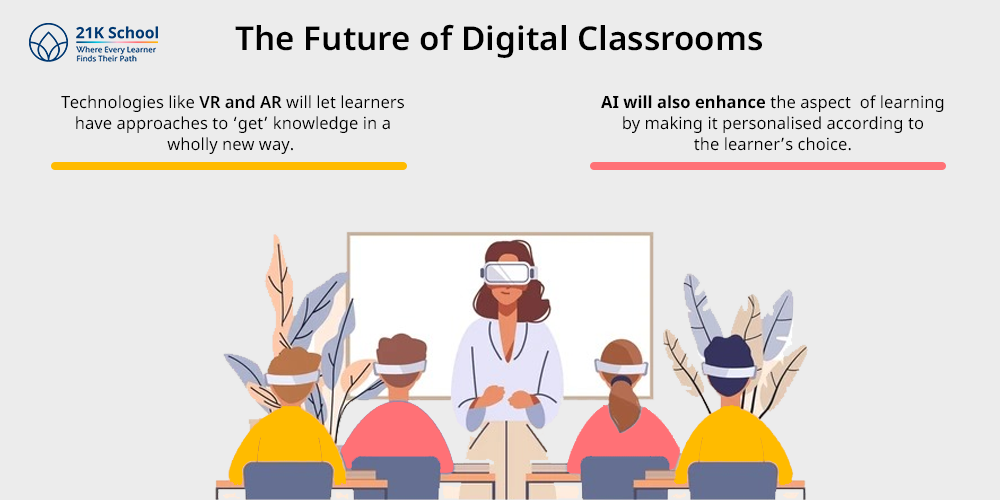
The education system of the future, without any doubt, is going to be digital. In the future, innovations will progress even more extensively, and asynchronous classes will become increasingly more realistic.
Technologies like VR and AR will let learners have approaches to ‘get’ knowledge in a wholly new way. AI will also enhance the aspect of learning by making it personalised according to the learner’s choice.
Conclusion
Digital classrooms as a concept have revolutionised how education is delivered, offering several advantages such as enhanced engagement, personalised learning, and increased accessibility.
21K School is one of the pioneers in this educational revolution, delivering the best homeschooling experience to all learners.
Therefore, future concepts point to the fact that digital classrooms will be quite paramount for accommodating education needs, making learning more inclusive and effective for all learners.


